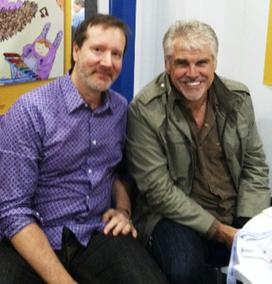 Film director Gary Ross (The Tale of Despereaux; The Hunger Games) has cast himself in a new role: author of the children's book Bartholomew Biddle and the Very Big Wind, illustrated by Matthew Myers (Candlewick, November). Ross and Myers met for the first time at BookExpo, and we got a chance to talk about their process and inspiration.
Film director Gary Ross (The Tale of Despereaux; The Hunger Games) has cast himself in a new role: author of the children's book Bartholomew Biddle and the Very Big Wind, illustrated by Matthew Myers (Candlewick, November). Ross and Myers met for the first time at BookExpo, and we got a chance to talk about their process and inspiration.
Ross first started this project as a favor to fellow director David Koepp, who needed a few lines for a bedtime story to be used in a scene he was shooting for The Trigger Effect. There was no budget to pay Ross for his authorial efforts, so Ross said, "I'll do it if the text can rhyme, and I retain the rights." After the film was released, Ross several people asked where they could purchase the book, and so he thought it was high time to get serious and put pen to paper.
The story opens when a big wind blows by Bartholomew Biddle's window. He picks up a bedsheet and sets sail, bound for pirates and past a bleak land of cookie-cutter workers and schoolboys. The narrative unspools in a Seussian rhyme scheme, visually accompanied by Matthew Myers's (Clink; Tyrannosaurus Dad) glorious oil paintings. Ross said he wrote 60% of the text over the course of a year. Sometimes he'd write two to three pages at a time, and at other points the flow went more slowly, to which Myers responded, "Sounds like painting." Ross said that, in addition to Seuss, he also admired the work of Caleb Brown and Chris Raschka's Charlie Parker Played Be Bop.
Ross said Candlewick publisher Karen Lotz had suggested three illustrators to him. Myers's work on Tyrannosaurus Dad convinced Ross that Myers was the artist for the project: "There was a freedom in it," Ross said. "It's painterly, loose, and emotionally packs a punch." "Thanks!" Myers responded. "That's like saying I was a comic actor who could play a serious role."
Author and artist continued their film analogies as they looked together at some key spreads from the book. Ross singled out Bartholomew's memory of drawing with his father, rendered as an aerial view by Myers. "That's an interesting place to put the camera," Ross told Myers. "It's as if we're eavesdropping on an intimate moment." Myers responded, "I'm like a director, too. It's as if Bart is watching his own memory." --Jennifer M. Brown

